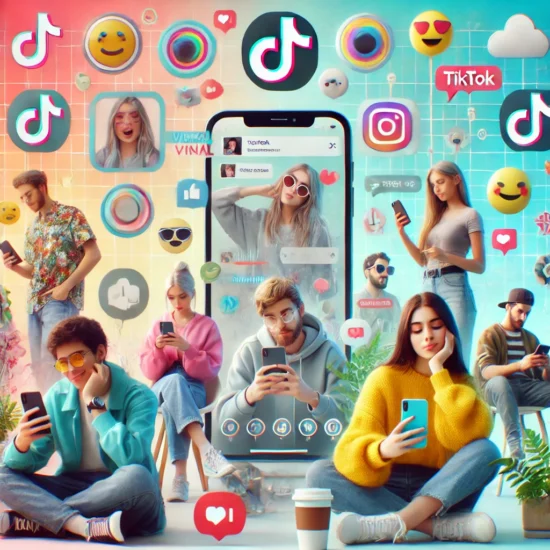How We See Each Other Trend on TikTok – In recent years, TikTok has emerged as more than just a leisure platform; it has become a cultural powerhouse, shaping how we perceive ourselves and others. With its brief-form motion pictures and viral trends.
The app has notably impacted social dynamics, giving an upward push to what many now refer to as the “how we see each other” fashion. This phenomenon revolves around how TikTok users gift themselves and decide others and how collective perceptions are shaped, frequently primarily based on look or conduct, in seconds.
TikTok’s unique rules curate content based on likes, stocks, and comments, continuously exposing customers to curated snapshots of different people’s lives. As a result, social evaluation has become a defining feature of the platform.
Many users unconsciously evaluate their lives, bodies, and personalities based on the idealized variations they see online. What was once an occasional issue of social media is now a regular revelation for thousands and thousands, wherein trends, demanding situations, and memes filter the manner humans understand others, regularly with oversized emphasis on looks and first impressions.
Despite the potential downsides of the ‘how we see each other’ trend, TikTok also serves as a platform for users to challenge stereotypes and express more diverse, genuine versions of themselves. Whether it’s redefining beauty standards, raising awareness about mental health, or sharing personal stories that challenge societal norms, TikTok fosters spaces for authentic conversations about how we view and interact with one another.
Moreover, the rise of micro-communities within TikTok has facilitated more nuanced discussions around identity, race, gender, and subculture. In essence, TikTok has not only amplified the ‘how we see each other’ trend but has also played a significant role in shaping our identities in an increasingly interconnected digital world.
The Evolution of Social Media Trends
To completely understand this shift, it’s crucial to remember the broader evolution of social media developments over the years. Social media has continually mirrored societal adjustments, adapting to new cultural moments and technological advancements.
Early platforms like MySpace and Facebook were dominated by long-shape posts and photos, even as Instagram delivered a more polished aesthetic and Twitter introduced rapid-paced statements. These structures all encouraged how we interact and perceive each other, but TikTok has taken this to another degree.
TikTok has redefined social media trends by blending viral challenges, user-generated content, and rules-driven feeds. It has created an environment where trends spread and evolve rapidly. The real-time engagement and short-form content not only allow users to watch but actively participate in shaping trends.
This participatory element has led to the rise of micro-trends, where niche groups shape and dissolve as quickly, often focused on identity, lifestyle, or shared values, making users feel more engaged and involved in the platform.
Social media is no longer just about staying connected—it has become a dynamic space where social perceptions are continuously crafted, challenged, and reshaped. As we move forward, structures like TikTok will continue to power this evolution, influencing how we see ourselves and each other on a greater fundamental level.

How the Trend Works
The “how we see each other” trend on TikTok operates through a unique blend of social interaction, content material advent, and algorithmic impact. The fashion flourishes on TikTok’s visually-pushed content material and the platform’s capacity to quickly spread trends through user participation.
Customers present themselves and perceive others primarily based on famous demanding situations, filters, and viral content material circulating in the app. One of the important drivers in this fashion is TikTok’s set of rules, which curates content material for each person’s “For You” web page.
This set of rules tracks user interactions—what they like, comment on, and share—and delivers more content aligned with the options. This procedure reinforces positive perceptions and pushes specific tendencies into the limelight.
As users devour similar content, forming judgments or comparisons based on appearance, lifestyle, or persona becomes less difficult, frequently reinforcing social norms or stereotypes. Additionally, TikTok’s viral challenges and visible storytelling form how others view users.
Whether it’s participating in a dance venture or joining a meme fashion, customers actively contribute to social belief. This dynamic creates a feedback loop: customers perform traits to be visible and, in doing so, affect how others understand them. As more human beings participate, fashion grows, perpetuating cycles of social comparison, self-expression, and external judgment.
Influence of Social Media Algorithms
Social media algorithms are important in shaping how we see each other by filtering and curating the content we interact with daily. Platforms like TikTok, Instagram, and Facebook lay out these algorithms to maximize engagement, displaying customers’ content that aligns with their preferences, behaviors, and past interactions.
While this personalized revel may be convenient, it appreciably affects how we perceive others and reinforces particular social developments. The algorithms aim to keep customers engaged for as many algorithms as possible. To do that, they reveal user hobbies—which include which posts are favored, commented on, or shared—after which they deliver greater content of an equal nature.
This ends in an “echo chamber” impact, where customers are repeatedly exposed to comparable content, restricting their exposure to diverse views. On TikTok, the “For You” web page performs a pivotal role in this system, imparting content tailored to character pastimes.
This creates a cycle of social comparison, as users regularly see popular movies presenting influencers, glamorous existence, or viral traits. Over time, those curated feeds form how customers understand splendor, fulfillment, relationships, and themselves. The algorithm’s amplification of viral traits similarly influences social perception, selling particular behaviors or ideas that could reinforce societal norms or unrealistic expectations.
In this way, social media algorithms don’t simply serve content; they form how users interact with and understand the arena. By constantly showing content that fits within their interests, customers’ views of themselves and others are continuously motivated, whether or not they are aware of it.

Viral Trends and Challenges
While algorithms impact what we see, viral trends and challenges are the driving pressure that unites customers on platforms like TikTok. Viral trends regularly start with an unmarried video or hashtag and rapidly spread as users reflect, remix, or adapt the content material.
The simplicity and accessibility of these trends make them appealing to a wide audience, allowing millions to take part and form how they’re perceived with the aid of others. The pace at which these challenges explode is another defining characteristic.
A brand new dance, meme, or venture can dominate TikTok’s “For You” page within days. By collaborating in those developments, users seek social validation, visibility, and engagement, contributing to a collective belief of what’s popular or essential within the second.
However, viral challenges aren’t just a laugh or leisure. They have deeper implications for social belief. Often, the most popular tendencies beef up unique ideals, whether it’s beauty requirements, lifestyle aspirations, or humor. Through repeated participation, customers contribute to growing, reinforcing, and modifying how we see and decide each other on social platforms like TikTok.
Conclusion
The “how we see each other” trend on TikTok exemplifies the platform’s profound role in shaping social perceptions and interactions in today’s modern age. Through the combination of viral demanding situations, visible storytelling, and algorithmic effects.
TikTok has created an area in which social comparison, judgment, and identification expression appear on an extraordinary scale. Users are not most effective in engaging with content material but actively collaborating in traits that affect how they understand others and how they, in turn, are perceived.
While this fashion can sometimes improve unrealistic expectations or stereotypes, TikTok additionally fosters spaces for actual self-expression and the breaking of societal norms. Whether pushing back against beauty standards, advocating for intellectual fitness, or participating in lighthearted, demanding situations, TikTok has opened new avenues for connection and expertise.
As social media continues to conform, platforms like TikTok will stay at the forefront of how we see and relate to each other. Recognizing the mechanisms that pressure these tendencies—viral content material, consumer participation, and algorithms—can help us navigate the digital global, acknowledging each its power to shape belief and the importance of fostering numerous, meaningful interactions.
Frequently Asked Questions
How can I see trending content on TikTok?
To see what is on TikTok, explore the “For “ou” page, curated by the app’s algorithm based primarily on famous content and your interactions. With the Discover function, you can also test out trending hashtags, situations, and movies.
How do TikTok trends shape how we perceive each other?
TikTok developments affect social notions by emphasizing certain beliefs, like look or lifestyle, through viral content. Users often evaluate themselves to others collaborating with the same traits, contributing to social assessment and how we decide on others based totally on visible storytelling.
How do I know if someone follows me back on TikTok?
You can see if a person follows you back on TikTok by visiting their profile. If both of you follow each other, it will show a mutual “Frie” ds” rep” station.
What are TikTok trends?
TikTok trends are viral content that spreads swiftly through the platform, often in the form of challenges, dances, memes, or particular hashtags. These trends outline much of the platform’s culture and influence how users interact and present themselves.
How do social media algorithms influence TikTok trends?
TikTok’s rules curate content based on user engagement, pushing viral developments into the spotlight by showing famous motion pictures on the “For “ou” web” page. This algorithm impacts how traits spread fast and shapes how we see ourselves and others.
Read More: https://topalways.co.uk/what-is-visual-merchandising/


